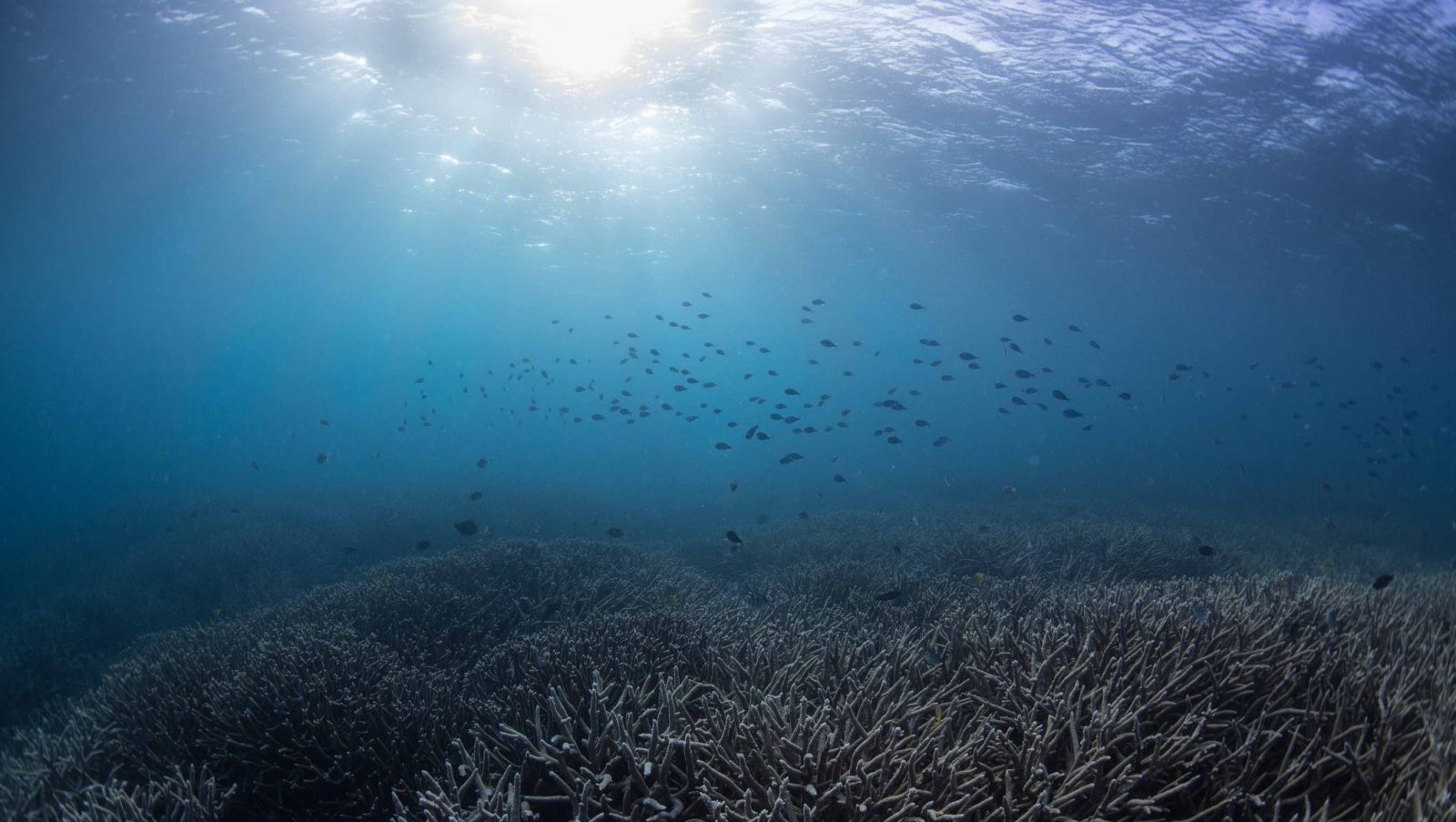This story originally appeared in bioGraphic, an online magazine about nature and sustainability powered by the California Academy of Sciences.
Valérie Chamberland swims like a dolphin, quickly and fluidly, and for most of the past hour she has been darting through the warm, shallow water off the Caribbean island of Curaçao. Now, she is dangling upside down, hovering above a pillow-sized brain coral. Her rubber fins twitch steadily overhead, and as she sips air from the aluminum tank on her back, a stream of bubbles rises from her regulator’s mouthpiece.
The reef spread below Chamberland isn’t one of those flashy, fluorescent gardens seen in calendar photos and nature documentaries. Only a few dozen yards from shore, it lies almost literally in the shadows of a stone jetty, a busy casino, and a Denny’s restaurant. The waters that surround it are murky, and most of its corals are brown and lumpy, sparsely accessorized with bright-purple vase sponges and waving, rusty-red sea fans.
But as anyone who studies coral reefs will tell you, beauty doesn’t necessarily equal health, and this reef has good vital signs. It retains plenty of what reef scientists call “structure” — meaning that it’s three-dimensional, not flattened into rubble or sand — and most of its unlovely lumps are formed by brain coral, one of the sturdiest types of coral in the Caribbean. The reef is lively with fish, and it lies on the outer edge of Curaçao’s wing-shaped coastline, where fast-moving currents sweep out at least some of the island’s pollution and slow the growth of coral-suffocating green algae. It’s also sheltered from major storm damage: Curaçao, which is only 40 miles north of Venezuela, rarely experiences hurricanes.
Chamberland flicks away an agitated crowd of silvery butterflyfish, then descends slightly for a closer look at the mound of brain coral. She inspects the meandering grooves on its surface, looking for the tiny white bumps that appear immediately before its annual spawning. For the butterflyfish, the pinhead-sized bundles of sperm and eggs released during a spawning event are a calorie-rich feast; for Chamberland, they’re the raw materials she needs to further a long-running mission.
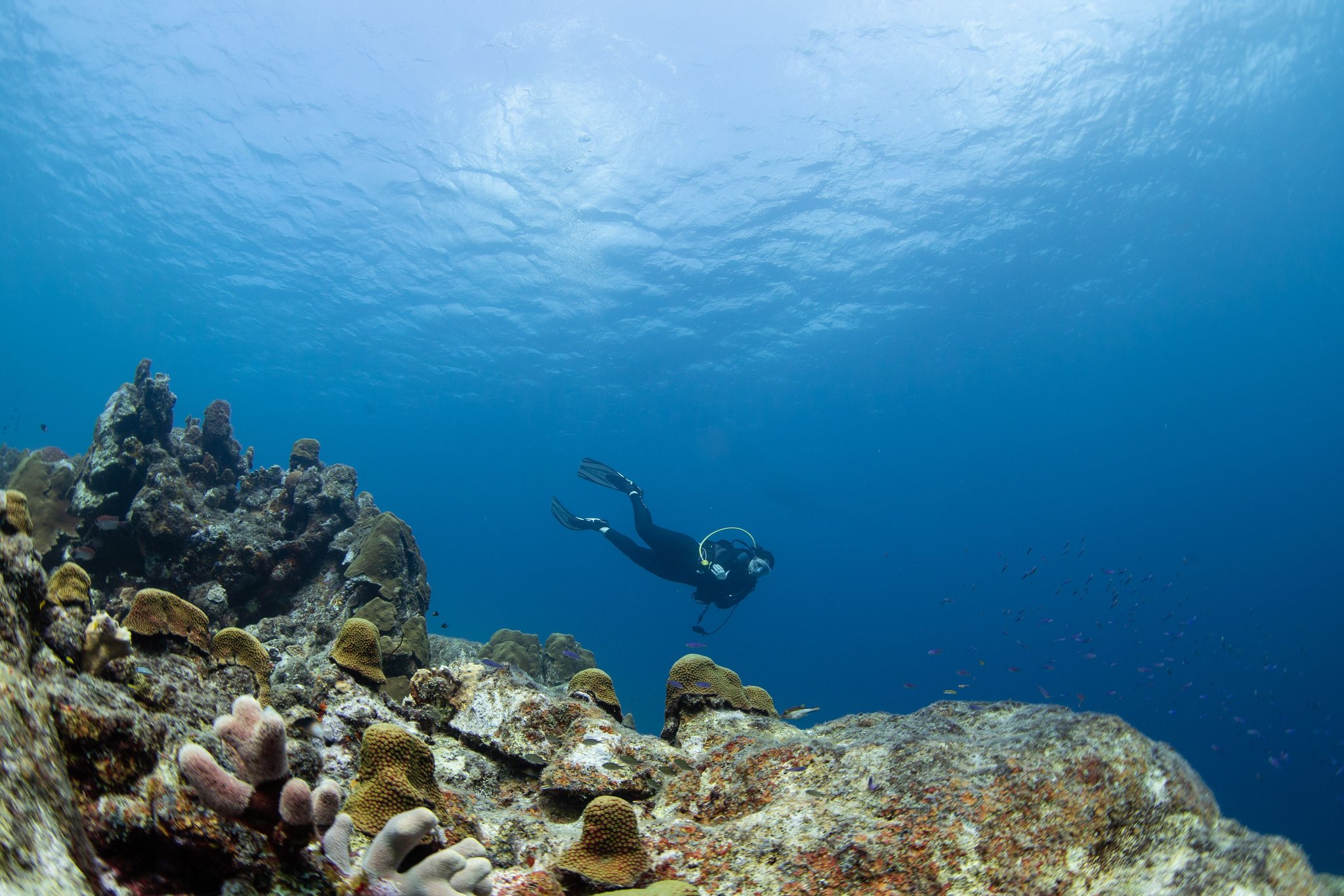
Valérie Chamberland descends over a coral reef. bioGraphic.
Over the past two decades, Chamberland and other scientists throughout the Caribbean — many of them now associated with a research and conservation group called SECORE, which stands for Sexual Coral Reproduction — have stubbornly advanced the art and science of raising coral babies. Through trial and error, these researchers have learned to better predict the quiet, hidden phenomenon of coral spawning, to fertilize coral eggs in the lab, and to foster young corals until they’re ready to grow in the open sea, on a living reef.
Newborn corals are, in their way, as high-maintenance and idiosyncratic as their human counterparts, and the process of raising and releasing them, formally known as “assisted recruitment,” is full of frustrations and disappointments. Thanks to some recent successes and to rising interest from conservationists, however, the job is becoming easier and cheaper. The progress is such that on Curaçao this past June, Chamberland and her colleagues hosted an intensive workshop in assisted recruitment for 10 park rangers, conservationists, biologists, and others from a half-dozen Caribbean islands, intending to both share the techniques they’ve developed and, in time, learn from the experiences of new practitioners.
Chamberland, who moved to Curaçao from Québec nearly a decade ago, sometimes feels as if she’s counting down to a rocket launch: After years of careful preparation, assisted recruitment is nearly ready to blast off into new territory.
On the reef, Chamberland finishes her inspection of the brain coral and leaves the butterflyfish to their vigil. She surfaces and takes off her mask, freeing its rubber strap from her dark hair. The setting sun pinkens her often serious face, and she grins. “Tomorrow night,” she says, her consonants softened by her native French. “It’ll happen tomorrow night.”
Gamete
On the first morning of the Curaçao workshop, Mark Vermeij wants to make two things clear: Raising coral from larvae isn’t easy, and baby corals are not, on their own, going to save the world’s coral reefs. “People have approached us and said, ‘Ah, that’s nice, because now the Great Barrier Reef is fine,’” he tells the participants. “And it’s like, ‘What on earth are you f-ing talking about?’”
Vermeij is a professor at the University of Amsterdam and the research director of CARMABI, a longstanding marine research and conservation center on Curaçao and a key supporter of SECORE. Originally from the Netherlands, he has studied coral spawning here and elsewhere in the Caribbean since the early 1990s. His imposing bulk, gray curls, and often-furrowed brow give him a piratical air, and his blunt opinions, delivered in fluent English, are punctuated with the occasional Dutch exclamation.
In a narrow, air-conditioned classroom at CARMABI headquarters, below a faded photograph of the Dutch king and queen, Vermeij reminds the participants that restoring coral reefs isn’t just about putting more coral in the ocean. It’s about dealing with chronic local problems like coastal development and water pollution — not to mention the multilayered, and increasingly obvious, effects of climate change on ocean habitats worldwide. “This is not a wonder tool,” he says sternly, glaring at the participants. “It will greatly depend on everything else you are doing, and everything else you are doing will depend on where you’re from.”
Despite his gruff manner, it’s clear that Vermeij is as pleased as Chamberland to be hosting this workshop. As the participants introduce themselves and describe their own attempts at coral restoration, Vermeij listens closely, asking questions and offering brusque encouragement.
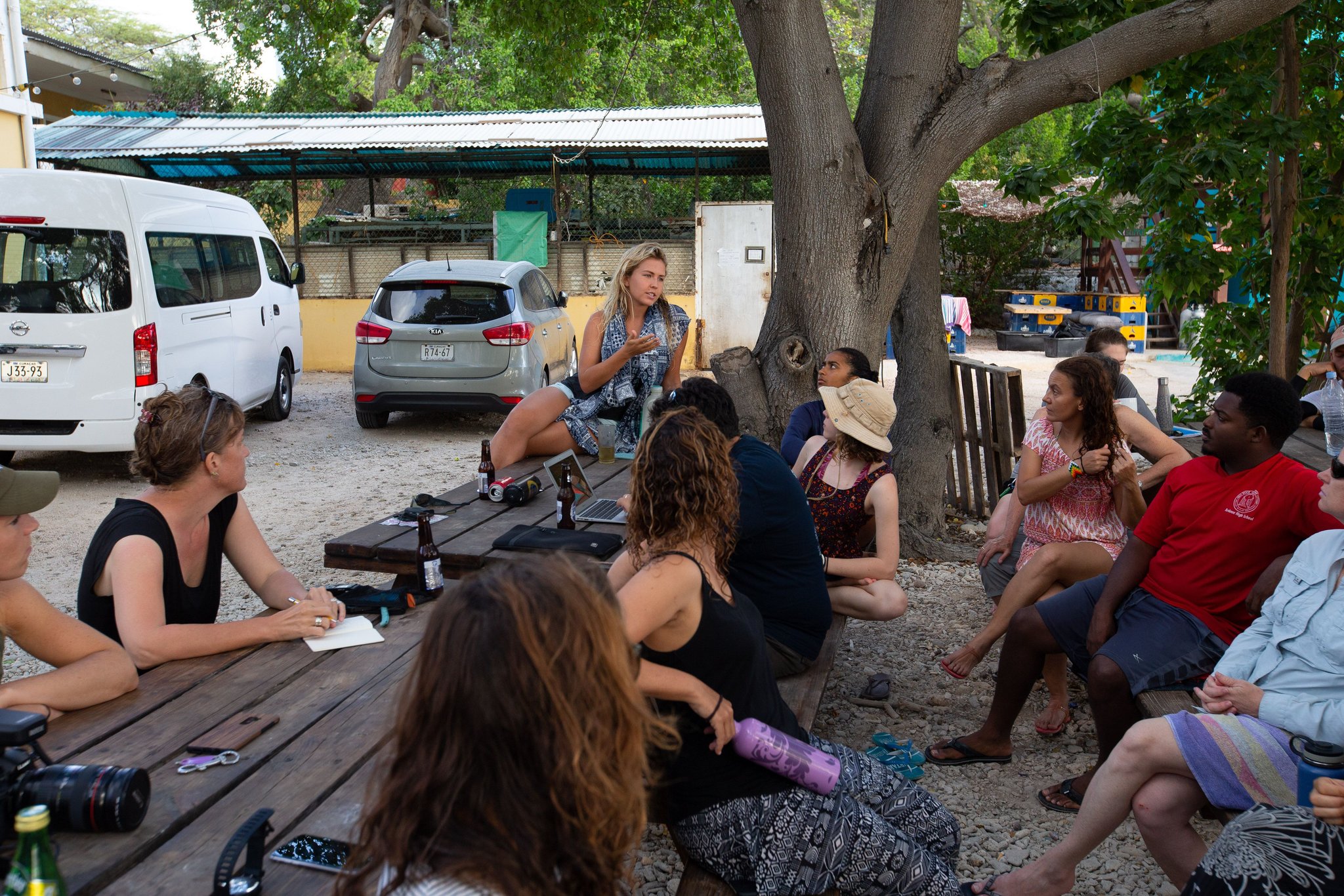
Workshop organizers and attendees discuss the challenges and potential of sexual coral restoration techniques in various locations around the Caribbean. bioGraphic.
Most people in this group are new to assisted recruitment, but everyone is familiar with the extraordinary — and extraordinarily complicated — life cycle of coral. That makes them unusual among humans, and unusual in human history, too. Not until the 1980s, after all, did researchers confirm that most corals can reproduce in two distinct ways: sexually and asexually.
Coral polyps, the tiny, tentacled invertebrate animals that, along with their symbiotic algae, form the living part of a coral reef, can reproduce asexually by budding off, or dividing, to form genetically identical versions of themselves. (What most of us think of as one coral — a ball, a column, a branching bouquet — is not a single organism but a colony of cloned polyps, nestled into a calcium carbonate skeleton formed over time by secretions from multiple generations of polyps.) Finger-sized bits of coral colonies can grow quite quickly via asexual reproduction, and conservationists around the Caribbean are beginning to “garden” these fragments: Francesca Virdis, the project coordinator of the Coral Restoration Foundation Bonaire, tells her fellow Curaçao workshop participants that her organization is encouraging the clonal growth of some 12,000 colonies of staghorn and elkhorn coral (Acropora cervicornis and Acropora palmata, respectively) by anchoring fragments on submerged scaffolds made of PVC pipe.
Once these cultivated colonies reach a certain size, they can be relocated and used to supplement the structure of reefs damaged by hurricanes, disease, or human activity. But Virdis and the other workshop participants know that coral gardening isn’t a wonder tool, either. To survive long-term, corals need not only structure but also genetic diversity, which is enhanced through sexual reproduction — the chance combination of sperm and eggs, or gametes, from different colonies. In most coral species, this cross-fertilization takes place during periodic spawning events, when colonies simultaneously release a brief blizzard of eggs and sperm into the open water. While colonies cultivated from fragments can eventually spawn and cross-fertilize, it takes years for any coral colony to reach maturity; the SECORE scientists believe that by cross-fertilizing coral at the beginning of the restoration process, they can bolster the variation corals need to evolve new defenses against changing conditions.
Many of the workshop participants live face to face with these changing conditions. Rita Sellares, the cheerfully determined executive director of FUNDEMAR, a small marine conservation nonprofit in the Dominican Republic, reports that several of her group’s coral gardens were smashed by recent hurricanes. Erik Houtepen, a young park ranger on the tiny island of Sint-Eustatius, says that his park’s gardens, which contained about 500 fragments, were completely destroyed in late 2017 by a double hit from hurricanes Irma and Maria; a few months later, after a laborious reconstruction, the gardens were again knocked flat, this time by a large storm surge. The park is experimenting with tying and gluing fragments directly to its reefs, and with scaffolds that can be sunk to deeper depths, further out of reach of storms. “If any one of you wants to be an intern for us, we could use you,” Houtepen says dryly.
Conservation of any sort is difficult work, and coral reef conservation can test the most optimistic soul: In the Caribbean alone, reefs are beset not only by destructive storms, but also by local pollution, rising ocean temperatures, at least 40 different infectious diseases, and the effects of worldwide ocean acidification. There is evidence that dust storms from the African Sahel region, exacerbated by climate change, carried a type of fungus into the Caribbean that now kills Gorgonian sea fans. Over the past 45 years, the overall extent of coral in the Caribbean has shrunk by more than half, both because colonies are dying off and, for reasons scientists don’t entirely understand, they’re not reproducing very well; in Florida, the extent of some coral species has declined by 90 percent.
While Pacific reefs have long been markedly healthier than those in the Caribbean, a series of enormous bleaching events, beginning in 2016, have affected massive swaths of the Great Barrier Reef and wiped out any remaining complacency among Pacific coral conservationists. (As seen in this earlier bioGraphic feature, Coral “bleaching” happens when ocean temperatures rise to levels that cause polyps to expel the symbiotic algae that give the hosts both their color and their main source of food.) Every experienced coral biologist, no matter where he or she works, has a story about a favorite reef that is forever changed.
Kara Rising, SECORE’s administrative manager, recently closed her psychotherapy practice in Ohio in order to devote herself to ocean conservation, and she’s often struck by the unrelenting emotional toll of conservation work. “There are times when I think, ‘Hey, should we have a bit of group therapy here?’” she says with a laugh.
Yet the grimmest story about the world’s coral reefs is also the simplest. For the conservationists in the Curaçao workshop, hope lies in complexity, in the many overlooked departures from the mean. Some corals are killed outright by bleaching, for instance, but not all; some species withstand it better or recover from it more quickly, and some colonies within species seem to be more resilient, too. Some species, like the Caribbean’s threatened staghorn and elkhorn corals, grow very quickly but are particularly vulnerable to stress; other species, like the brain corals, grow slowly but can tolerate a lot.
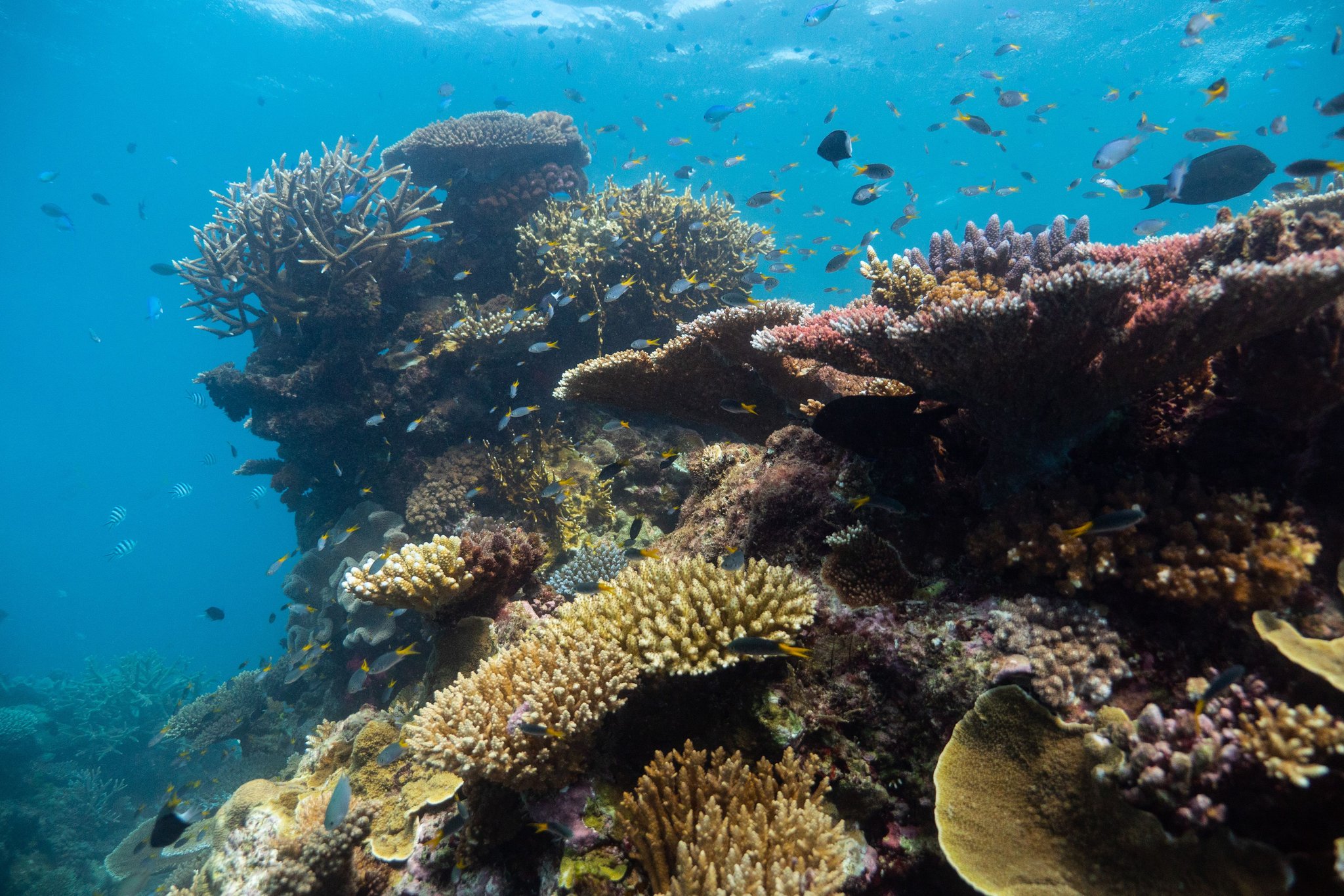
bioGraphic.
“Corals are in a critical situation, but they’re not as flimsy as we think,” says Chamberland. “If we give them a chance to deal with just one or two stresses instead of six, some can survive, and those that do are the ones we should be studying. We should be asking, ‘What do they do that makes them win?’”
Chamberland, Vermeij, and the other researchers associated with SECORE have concluded that if they can help preserve variation, they can help preserve hope. And their first step toward preserving hope is to catch some corals in the act — to collect a few hundred thousand coral eggs and sperm as they’re released into the ocean.
In the CARMABI classroom, Chamberland explains the protocol for gamete collection, laying out the cone-shaped nets that will be draped over the coral colonies and the plastic collection tubes that will catch gametes from Diploria labyrinthiformis, the species of brain coral affectionately known as D. lab. The nets are made from tarps, and none of the gear is high-tech — in fact, it’s deliberately designed to be low-tech, accessible to conservationists with even fewer resources than those at this modest field station.
Chamberland describes how gametes are handled back in the lab, long after dark, and how researchers sometimes keep watch on the embryos until the next morning. When she asks if there are any questions, Houtepen raises his hand. “So,” he says hesitantly, “do you sleep during this process?”
Chamberland laughs, but doesn’t answer. “Let’s do this,” she says.
Embryo
The D. labs near Curaçao are most likely to spawn at sunset on Friday, and as the hour approaches, the group’s collective agitation grows. Conversations are louder and an octave higher; the next cigarette is lit by the last. Pickup trucks are loaded with heavy plastic tubs of dive gear, air tanks are stacked and secured, and the collecting tubes and nets are checked and recounted. The bursts of friendly laughter turn jagged.
The phenomenon of mass coral spawning was unknown to science until 1981, when a group of Australian graduate students witnessed a spawning during a nighttime dive on the Great Barrier Reef. Ever since, scientists have been trying to work out the spawning schedules of different species, but it’s not easy. Spawning generally happens at night, and generally about a week after the full moon — corals are thought to have primitive photoreceptors that can detect moonlight — but the precise timing varies by species and location, and some species are more predictable than others. Some, like D. lab, spawn at regular monthly intervals, with only a few colonies spawning each time. Others, like staghorn and elkhorn corals, release their annual hoard of gametes all at once, in the fall, on a date that changes from year to year.
It’s easy to be a day early, or an hour late, and miss a spawning completely, and over the years researchers have spent evening after evening shivering in the ocean, waiting for a spawn they may never see. “It’s a little bit addictive,” says SECORE research director Margaret Miller, who was involved in some of the first studies of coral spawning in the Caribbean. Swimming through a spawning can be oddly exhilarating, and missing one can be agonizing — especially for scientists whose research depends on a decent haul of gametes. “Every year, you’re at risk of getting skunked,” says Miller.
The conservationists in Curaçao are thoroughly infected with the drama of spawning, partly because at some point in their lives, each has been infected with a passion for coral reefs. Every coral enthusiast remembers when he or she discovered the hidden world of reefs, whether it was through Jacques Cousteau television specials (a surprisingly common route, even for younger reef conservationists), with a borrowed mask and snorkel on an idle childhood afternoon, or during a college course taken on a whim. Some were struck first by the colorful beauty of the reefs, or by the abundance and weird variety of its life forms; some were enchanted by scuba diving, which allows even the clumsiest human to float gracefully through an alien world. Some consider the coral life cycle as beautiful and complex as great art. “I find it elegant,” says Vermeij.
Everyone here has also gone to some trouble to look more closely at corals. Few people get near them by accident, even those who grow up by the beach. Coral reefs are very rarely as close to shore as they are in Curaçao, and we air-breathing humans are, of course, perpetual strangers in coral habitat.
Elvira Alvarado, one of the workshop participants, is a professor at the University of Bogotá in Colombia who has been studying coral reproduction since the early 1990s. She learned to dive in the 1970s when she and a group of university friends, after being entranced by the coral reefs on Colombia’s Caribbean coast during a snorkeling trip, rigged up primitive dive gear with borrowed tanks and repurposed life vests. Their methods and equipment would give any modern-day dive instructor the vapors: “We didn’t have gauges, so we’d just guess our depth by the species we saw, and go up when breathing started to get hard,” she remembers with a smile. Dive gear and training are widely available today, but it’s costly, and inaccessible to most people on Earth — including many of those who live closest to coral reefs, and whose lives depend most directly on the fish these ecosystems shelter and the coastal protection they provide.
Given all the time, energy, and passion invested in them, coral spawning dives practically vibrate with nerves, and this one is no exception. Chamberland warns the group against “dive panic” and “drive panic,” which can lead otherwise sober-minded researchers to abandon basic water safety and road rules. Some, in their elated rush back to the lab, have knocked precious vials of gametes off pickup tailgates.
The group splits into two teams, and one heads for the stone jetty where Chamberland dove the previous evening. After donning wetsuits and tanks and checking their gauges, the divers wade into the surf, collection nets and tubes in hand, and swim beyond the jetty. At a signal from Chamberland, they descend, and the noise of waves and traffic abruptly stops, replaced by the rhythmic whoosh of their own breathing and a distant, staticky crackle — the sound of hundreds of fish feeding along the reef.
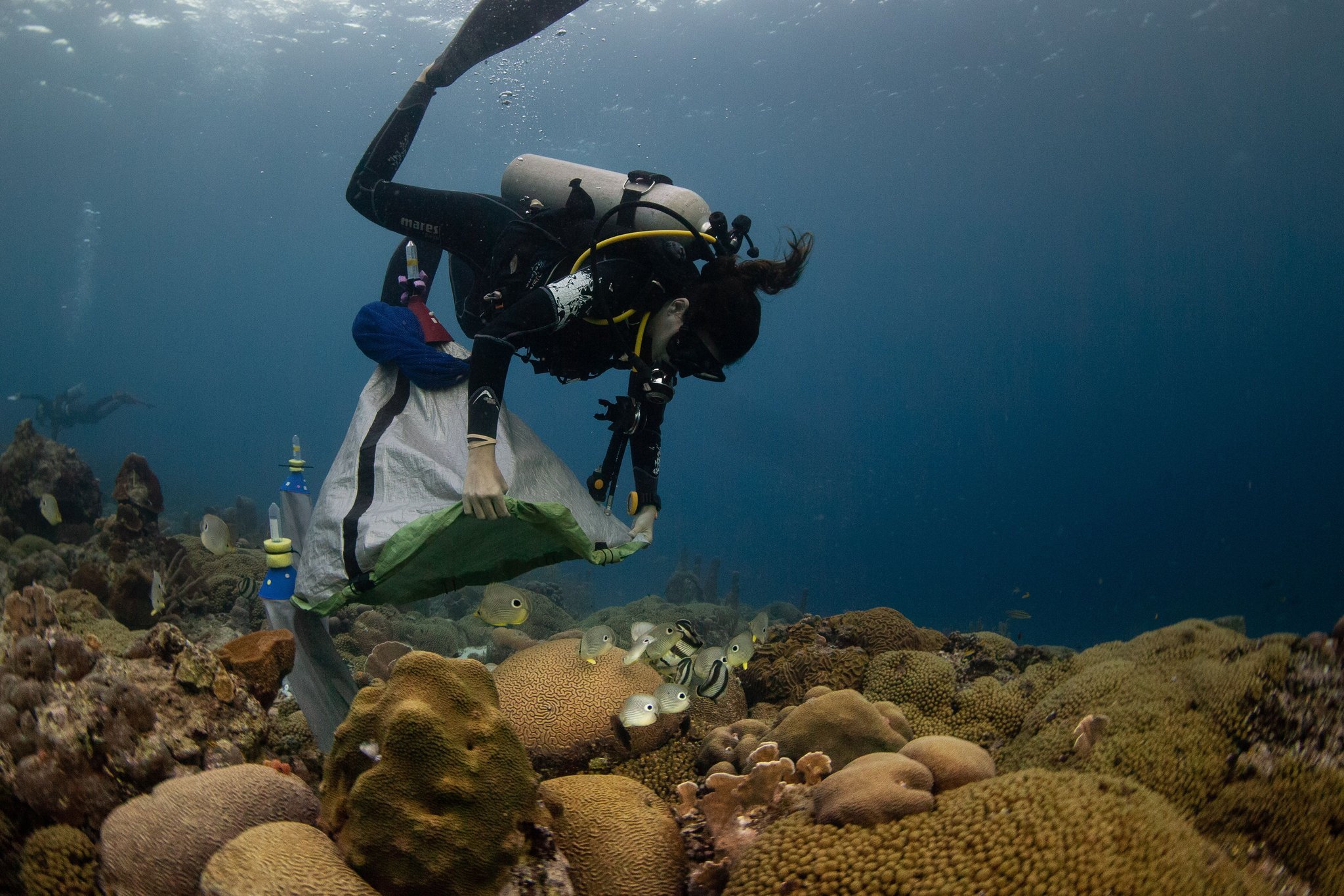
Valérie Chamberland places a net over a colony of grooved brain coral. bioGraphic.
Working in pairs, the group takes its cue from the swarms of butterflyfish that have again gathered in hopes of a gamete meal. The divers drape nets over the most popular mounds of D. lab, check the time on the dive computers on their wrists, and wait. Fifteen minutes pass, then 30. One pair of divers points excitedly to the tube at the top of one net: pinkish-gray spheres are floating into the tip. It’s happening! Another pair spots gametes rising out of a net, and then another. As the sun sets and the water starts to darken, the divers cap and detach the collection tubes and gather up the nets, making their way back to shore by the beams of their dive lights.
At the surface, the mood is subdued. The spawn wasn’t as big as everyone hoped it would be; this team has only a few vials of gametes, and none is full. Maybe the other team got more; maybe there will be more tomorrow evening. Maybe it’s just a bad month.
Back in the CARMABI lab, though, spirits rise. The divers argue good-naturedly over which team, and which pair, returned with the most gametes, and when all the tubes are lined up on the lab bench, it turns out that there are more eggs and sperm than the equipment on hand can handle. “A lot of dribbles adds up to a pretty good catch,” says Chamberland. Even more important than volume is variety, and the group has managed to collect gametes from a lot of different colonies. “We have 18 parents!” Chamberland exclaims to Vermeij, who raises his eyebrows comically. “I’m … jealous?” he says. The variation among the gametes is obvious, even to the untrained eye; the batches of egg and sperm bundles range in color from purplish-gray to pink to beige.
The SECORE researchers and workshop participants, who are crowded into the small lab, are still wet from the dive; some are in their swimsuits, with lingering pressure marks from their masks on their faces. But everyone is carefully obeying the laboratory rules: no touching or even leaning over the vials, since sweat and sunscreen can disrupt fertilization. No mosquito repellent anywhere near the lab. The room is closed and muggy — 83 degrees Fahrenheit, to be exact, the current surface temperature of the ocean — and as Chamberland uncaps the vials and mixes the bundles into laboratory pitchers filled with seawater, the group is almost reverently quiet. “You’re making me nervous,” Chamberland jokes. In the pitchers, the bundles are already breaking up, and the sperm and eggs are floating freely.
Assisted recruitment is, in some ways, as much art as science, and some of its steps can’t be precisely expressed in a lab protocol. The SECORE researchers have learned, for instance, to dilute the concentration of sperm in the pitchers so that the resulting larvae have the room — and oxygen — they need to develop. “The water in the pitchers should look like fogged-up glasses,” Vermeij says. When Chamberland says, “I think of it as looking like weak lemonade,” Vermeij, who was her Ph.D. adviser and has worked alongside her for years, looks genuinely puzzled. No two people handle coral gametes in exactly the same way.
“Anybody thinking of trying this at home, so to speak?” Vermeij asks the group. Rita Sellares, of FUNDEMAR, says that one of her graduate students recently made a bare-bones attempt at assisted recruitment, turning Sellares’s office into a makeshift lab and filtering seawater through a swimsuit. To everyone’s astonishment, the larvae survived. “Hey, if it works, it works,” says Vermeij. Coral gametes are frustratingly finicky, but once in a while, they’re not; during a trip to Mexico a few years ago, Vermeij collected a few gamete bundles in a coffee cup, and the resulting larvae did just fine.
Chamberland stands back from the lab bench, satisfied with her weak lemonade. “This is pretty much where we wait for the magic to happen,” she says. Over the next few hours, the gametes will combine to form embryos, and overnight, the embryos will develop into larvae. The spectators wish the gametes luck and adjourn to a late dinner, which they eat at a row of surfside picnic tables and wash down with bottles of Venezuelan pilsner. On the balcony above, cleaned and drying collection nets hang over the railing like so many gray ghosts.
Late that night, restoration technician Kelly Latijnhouwers pours about half of the brand-new embryos — about 100,000 nearly invisible specks — into a plastic water jug and, with a number of workshop participants in tow, drives them across town to the Curaçao Seaquarium. There, in a quiet channel not far from the dolphin show and the shark tank, SECORE has set up a floating coral nursery, an experimental design that looks something like a very sturdy, highly engineered kiddie pool. If it works, it could eventually eliminate the need for a temperature-controlled laboratory, making assisted recruitment more affordable and accessible for small conservation groups.
Latijnhouwers lies belly down on the dock next to the nursery, hoists up the jug of embryos, and carefully tips it in. The workshop participants, seated on the seawall nearby, applaud, and Latijnhouwers scrambles to her feet with a smile, mockingly acknowledging the cheers. It’s close to midnight, and there’s still work to do.
Larva
The SECORE researchers have learned to resist dive panic and drive panic, but they can’t stand to be separated from their coral babies. The morning after the gamete dive, the streets around the CARMABI lab are unexpectedly blocked; hundreds of people are ambling along the main road, merrily throwing colored powder at one another as part of a community charity walk. Latijnhouwers arrives at the lab late, short on sleep, and grumpy about having had to shoulder her way through the crowd. She grew up on Curaçao and likes the informality of island life, but not when tens of thousands of larvae are waiting for her care. “They were f-ing tossing colors on me!” she says, laughing but still outraged.
The larvae in the lab, though, are doing well. They’re now distributed among 64 plastic deli containers, which the scientists refer to as “swimming pools,” and they’re moving slowly through their small puddles of seawater, barely visible but full of potential. “Every one of them could become a great big brain coral. That’s insane, right?” Chamberland says happily.
This morning, teams of workshop participants are using sheets of plastic cling wrap to skim dead sperm off the surface of the swimming pools. It’s fussy, tedious work, and Latijnhouwers soon pulls out her phone and fills the lab with the reggae-soul sound of local musician Stanley Clementina.
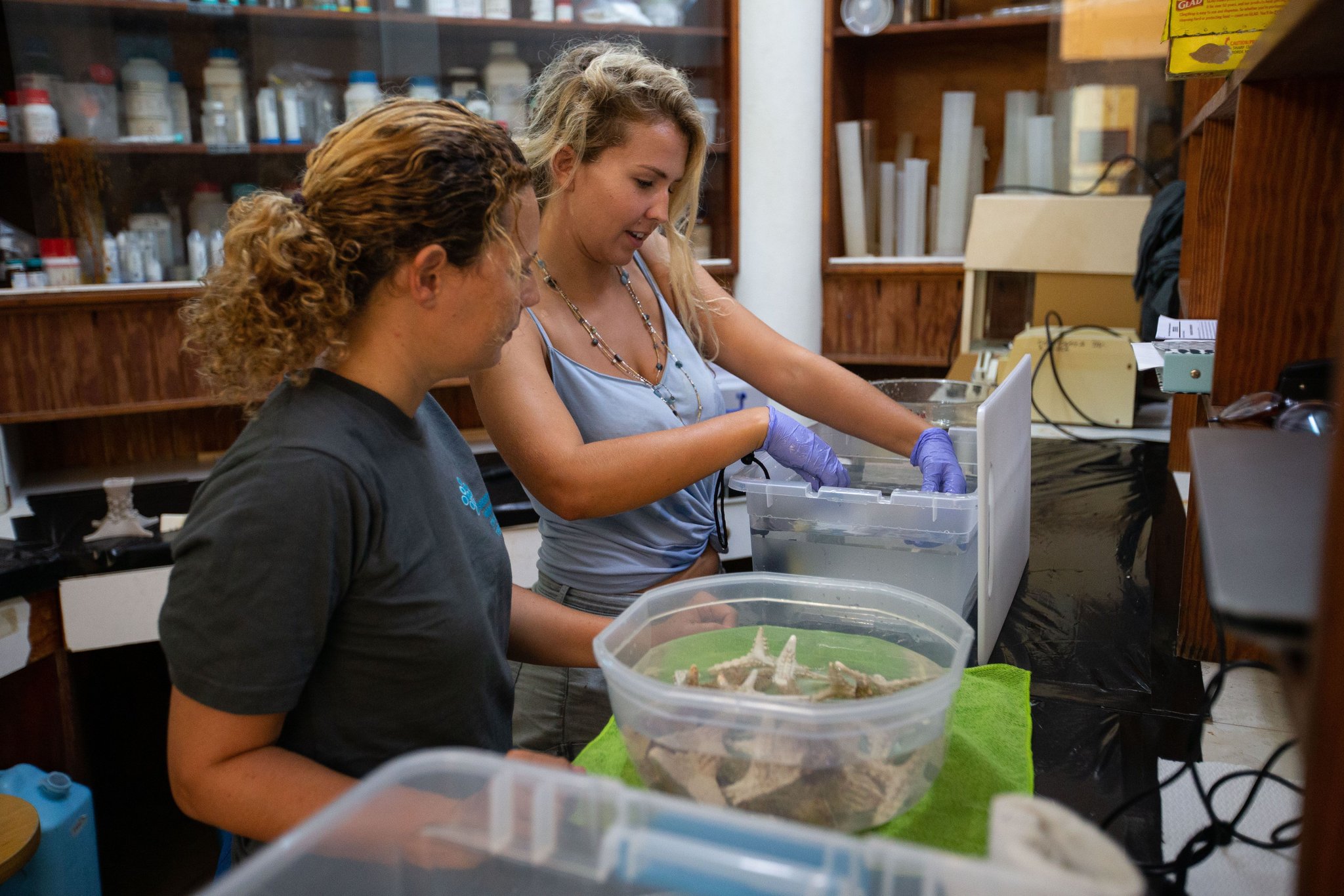
Researchers prepare settlement tiles that will be provided to a new generation of coral larvae. bioGraphic.
Such a large and willing crew of helpers was unimaginable in 2002, when SECORE was founded by German coral researcher Dirk Petersen. Petersen, then working at the Rotterdam Zoo, initially focused on helping zoos and aquariums boost the genetic diversity of their coral collections, but he soon began to consider how assisted recruitment could be used to restore reefs in the open ocean, on a large scale.
Petersen knew that any such large-scale undertaking was a long way off, not only because of the technical challenges but also because at the time, the notion of active restoration was viewed with suspicion, even hostility, by many conservationists. Some thought it just wouldn’t work; some feared it would distract from the more immediate job of protecting reefs; and more than a few disliked the idea of tinkering with a natural process, especially the elegant intricacy of coral reproduction.
In Australia, where the reefs were relatively healthy, restoration was “a dirty word,” says marine biologist and workshop co-organizer Joe Pollock, who spent several years studying corals on the Great Barrier Reef before moving to the Caribbean. “The attitude was, ‘That’s something they do in the Caribbean, because they’re really messed up and don’t have any other options.’” Australian conservationists talked instead about “managing for resilience” — protecting reefs so that corals could, on their own, evolve defenses against new stresses.
In Florida, where the reefs were already desperately degraded, conservationists wondered if any kind of reef restoration was worth pursuing; in an academic journal in 2005, managers of several marine protected areas published an opinion piece called “The Folly of Coral Restoration Programs Following Natural Disturbances in the Florida Keys National Marine Sanctuary.”
Today, the conversation is different. “The paradigm has changed blindingly fast because the decline has happened blindingly fast,” says Miller. “Now, everything is on the table.” In the wake of the 2016 bleaching event, Australian conservationists began asking Caribbean researchers for help with assisted recruitment, and SECORE and other coral reproduction researchers received funding from sources including The Nature Conservancy, the California Academy of Sciences, and Microsoft founder Paul Allen.
“We’re trying to figure out how this fits within the solutions we have at our disposal,” says Pollock, who now heads The Nature Conservancy’s Caribbean coral conservation program. “We’re working on regional issues, trying to increase protection, getting involved with work that’s happening on a local scale, and at the same time trying to develop and disseminate these promising technologies that — I’ll be the first to tell you — are not the solution right now, but could be part of the solution down the line.”
Although discussions of the risks of “tinkering” with reefs continue, resistance has begun to fade. While managers and conservation groups alike continue to manage for resilience, they are seriously considering interventions once considered heretical, from assisted recruitment to the transplantation of corals into new ecosystems to the inoculation of coral polyps with symbiotic algae known to be heat-resistant.
In a quieter but perhaps even more significant departure from conservation tradition, SECORE has expanded its focus beyond critically threatened corals, and its researchers are now developing assisted recruitment techniques for a dozen different species, many of them still common.
“Most of the funds for this kind of work go to endangered species, and that’s a pity, because over and over and over again people are failing with the same species,” says Chamberland. “It’s just not feasible to bring everything back everywhere — some reefs are too degraded.”
The primary goal of reef conservation, these days, isn’t to preserve pristine reefs — most of those are gone — but to preserve at least some reef structure, some habitat for fish and other marine species, some ability to evolve. It’s to help protect Caribbean shorelines from strengthening Atlantic hurricanes, and to beat back the toxic bacteria and reef-suffocating green algae that thrive on degraded reefs. It’s to prevent wholesale coral loss as global temperatures rise, in the hopes of having some diversity left if and when climate stability is restored.
“If we want anything that resembles a coral reef in the future, we’re going to have to put our thumbs in the dike for the next 10 or 20 or 30 years,” says Miller. “We’re going to have to be very actively engaged for decades just to maintain the puzzle pieces, just so we have something to work with when the environment gets fixed.”
While interest in assisted recruitment swells, SECORE researchers are still trying to perfect their techniques — and in the humid warmth of the CARMABI lab, the young D. lab corals are about to enter the riskiest phase of their development.
Polyp
Coral larvae are, basically, tiny blobs of fat. When they finish consuming their fat stores and sink to the bottom of the ocean — a process called “settling” — they metamorphose into polyps, the initially-transparent micro-critters that make up coral colonies. (In some species of coral, polyps produced through internal fertilization are released from their parents with their symbiotic algae already in place; in others, polyps must take up symbionts from the surrounding water.) When polyps mature, they can reproduce asexually by dividing or budding off, or they can reproduce sexually by releasing gametes.
Before polyps can reproduce, though, they have to make it to adulthood, and even in the most successful SECORE experiments, the survival rate of lab-raised polyps during their first year on the reef is about the same as that of their ocean-raised cousins: 10 percent. Improving lab-raised polyps’ chances of survival is the biggest remaining technical challenge for assisted recruitment. “You can upscale all you want, but if you don’t manage to have high enough survivorship, you’re not going to get the end result you’re looking for,” says Chamberland.
The problem could be that lab-raised larvae aren’t as healthy as they might be; the SECORE researchers are careful when mixing gametes not only because they want the resulting larvae to survive, but also because they want the larvae to be in top form before beginning their dangerous journey through polyphood to maturity. Raphael Ritson-Williams, a researcher at the California Academy of Sciences who studies larval settlement, says, “There’s no physical thing you can see in larvae that will tell you they’re not healthy. They’re not sneezing or blowing their noses. But if they’re under stress, it can manifest itself later, and break the cycle of reproduction.”
Survival may also have a lot to do with the neighborhood in which coral larvae choose to settle. And they do, in fact, choose. Even though larvae have no arms, legs, or fins, they can swim, using their tiny hairlike cilia; even though they have no brains, eyes, noses, or mouths, they are surprisingly opinionated.
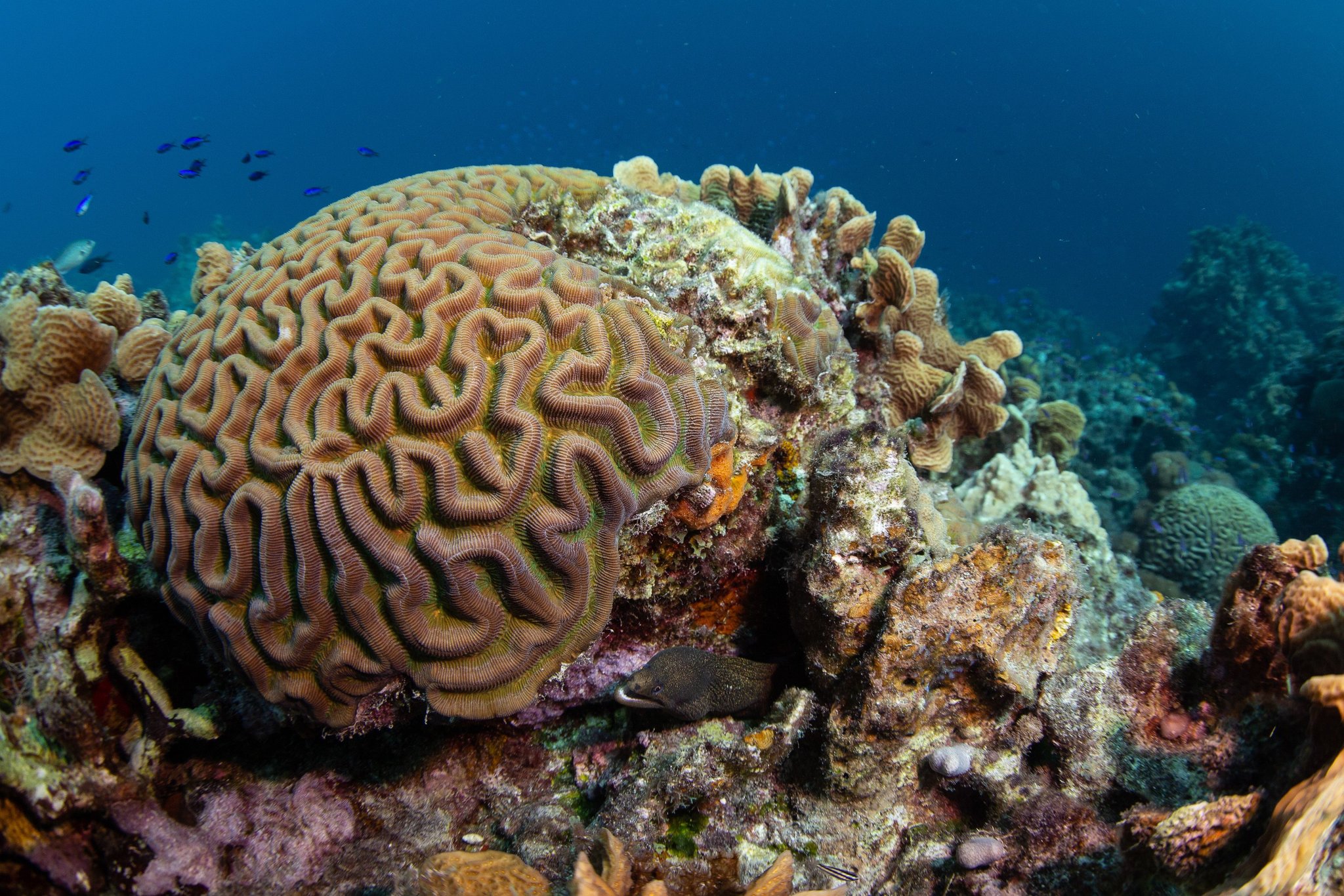
Colony of brain coral. bioGraphic.
Vermeij and his colleagues have found that in the open water, coral larvae swim toward reef sounds; other researchers have discovered that larvae can sense chemical cues and even perceive color, favoring a particular shade of red — a shade that matches the species of rock-hard red algae, known as crustose coralline algae, they most like to settle next to. Larvae also seem to prefer certain textures, choosing to settle on surfaces that are rough but not too rough. (Since a coral colony can occupy a chosen location for hundreds or even thousands of years — essentially indefinitely, as long as no one interferes with it and its polyps keep multiplying — maybe it’s not all that surprising that larvae are selected to be selective.)
So, like fretful parents of picky children, the SECORE researchers keep presenting their lab-raised larvae with choices, hoping to hit on the ideal menu. Ritson-Williams has found that while larvae like to settle near some species of coralline algae, other species inhibit larval growth. Unfortunately, the helpful and unhelpful species of algae look exactly alike — unless you happen to be a coral larva, or a coral scientist with a microscope and a lot of algal expertise.
Early SECORE experiments used hand-cut clay tiles as a surface for settlement, but soon found that clay tetrapods gave the larvae additional surfaces on which to settle and a better shot at survival. Chamberland and other SECORE scientists are now working with the design-software company Autodesk to develop 3D-printed settlement tiles in a variety of textures and fantastical shapes.
In the CARMABI lab, the D. lab swimming pools have been furnished with an array of clay settlement tiles, and the larvae are starting to make their choices. Though they’re still almost too small to see, Chamberland uses an ultraviolet flashlight to illuminate the corals’ fluorescent pigments, and finds that several glowing green dots have come to rest on the submerged tiles — the first of what she hopes will eventually be thousands of settlers. The odds are daunting, and so are the number of variables. No matter how carefully and thoroughly the SECORE researchers tweak the conditions in these swimming pools, it sometimes seems impossible that one of these pinhead-sized dots could survive to adulthood — much less multiply into a thriving colony. Robert Steneck is a marine biologist at the University of Maine who has helped the Caribbean island of Bonaire improve the resilience of its reefs by protecting the fish species that control algae growth. He cautions that lab-raised corals may never be able to make a cost-effective contribution to reef resilience. “You have to be mindful of natural mortality rates, and of what small fraction of a lot of effort is going to be successful 10 or 20 years down the road,” he says. “And you have to be mindful of the scale at which you’re going to be able to implement these very money- and time- intensive activities.”
But in the shallow ocean near the Seaquarium, just a few hundred yards from the floating coral nursery where Latijnhouwers deposited the rest of the D. lab larvae, is a bright-yellow elkhorn coral colony, a broad, scallop-edged funnel about a meter (3 feet) across. Seven years ago, this colony was a lone dot on a tetrapod in the CARMABI lab; just four years after the tetrapod was planted on the reef, Latijnhouwers was finishing a routine spawning dive when she checked the young colony and saw that it was releasing gametes.
For the first time, she realized, a SECORE-raised colony had completed the coral life cycle, and was contributing to the genetic stock of a living reef. Latijnhouwers, elated, surfaced into the warm night air, tossed aside her regulator, and called out to Chamberland, who was waiting on shore.
“Val!!” she yelled. “Your babies are spawning!!”
Colony
The D. lab corals, if they make it to adulthood, will have to survive in the world as it is: a world in which the climate is changing, the ocean is acidifying, and the forces of politics and history affect both land and sea. Curaçao, a former Dutch colony, became a separate country in 2010, but it remains part of the Kingdom of the Netherlands, which oversees its foreign policy.
For almost two centuries, the island was a hub of the Dutch slave trade, and like other Caribbean countries, its multiracial, multilingual society continues to struggle with the painful legacies of slavery and colonialism. Political corruption is commonplace, and political violence is not unknown. But politics, not science, will ultimately determine the future of reefs; most of the work of coral conservation has to happen on land, and in cooperation with policymakers.
Vermeij, who as the director of CARMABI is deeply involved in local conservation efforts, is impatient with the dire story still told by many prominent marine scientists. “The story that comes out of science is such a dark one that a lot of people are like, ‘Well, that was nice — like the dinosaurs, coral reefs were once there, but now they’re over, they’re done.’ If science only paints the obituary of coral reefs, no one’s going to throw money at them.”
He’d like to see conservationists talk less about the very real problem and more about what he sees as the solution: finding and encouraging the variation that will help reefs persist. He also thinks coral advocates should choose where they can do the most good, and, on occasion, concede defeat. “Scientists would be more credible if they would at some point say, ‘Reefs like this no longer deserve attention, let them go,’” he says.
On the last day of the workshop, the group readies its gear for one last dive. This time, they wade into the surf in front of the local Marriott. Latijnhouwers steps on a sea urchin and gets a long spine in her foot, but remains calm as she paddles beyond the waves. “You’re hard as nails,” says Rising.
“Not really,” says Latijnhouwers with a grimace. “This one actually hurts.”
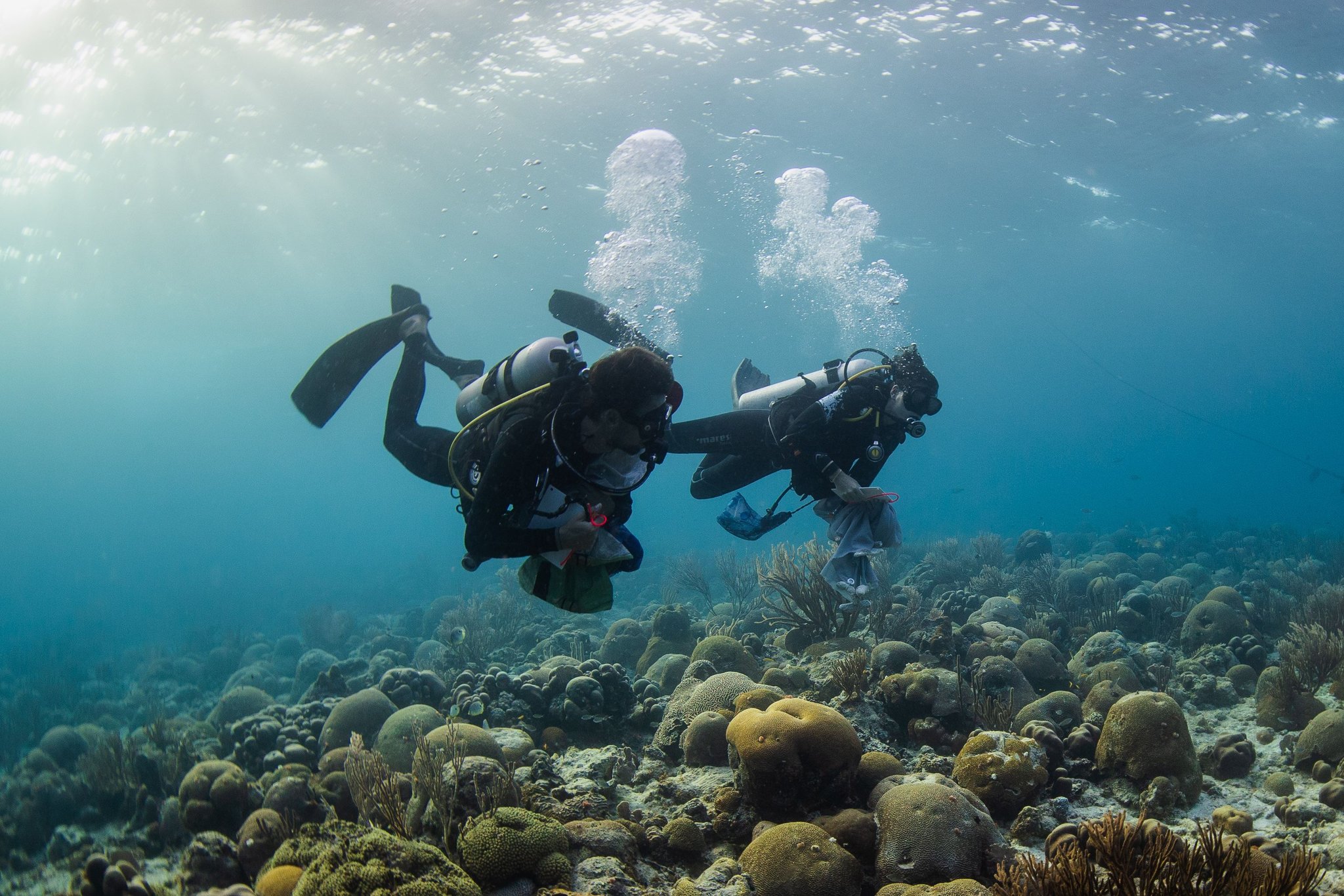
Valérie Chamberland and Erik Houtepen, a park ranger on the island of Sint-Eustatius, look for signs of spawning in grooved brain coral colonies (Diploria labyrinthiformis). bioGraphic.
When the group descends below the surface, it is confronted with one of the island’s most degraded reefs. There’s little coral here, and there’s a great deal of sand, pebbles, and green, leafy algae. Much has been lost, and much is unlikely to be recovered. But tucked into the crevices of the rocky seawall are a few dozen clay tetrapods — part of an experiment started by the SECORE team last year.
The colonies of threatened elkhorn coral polyps on the tetrapods are just dark smudges, each barely bigger than a thumbprint, but they’re alive and growing. If they can persist until they’re taller than the surrounding banks of green algae, their long-term chances will be good. Some evening years from now, under a waning moon, one or more of these colonies might spawn.
SECORE founder Dirk Petersen hasn’t yet realized his vision of large-scale reef restoration, but these tetrapods are, in fact, a small step toward it. Since they can tumble into a stable position on a reef instead of needing to be hand-placed, they could one day be tossed from boats in bulk, allowing conservationists to sow coral polyps far and wide. However, Petersen emphasizes, there is no ideal technique. “The goal is to create resilience at scale,” he says. “Whatever leads us to that goal is great.”
At the end of the workshop, as the participants get ready to depart for their respective islands, Rita Sellares of FUNDEMAR adds an extra item to her baggage: a box packed with 200 clay settlement tiles. Following her team’s DIY experiments with assisted recruitment in the Dominican Republic, she’s secured funding for a small wet lab and basic equipment, and plans to start a coral nursery.
For the rest of the summer, the participants keep in touch via a long string of WhatsApp messages, exchanging birthday greetings and coral spawning reports. On Sunday, September 2, Kimani Kitson-Walters, a native of Jamaica who works at the Caribbean Netherlands Science Institute on Sint-Eustatius, reports — with celebratory emojis — that Sint-Eustatius’s elkhorn coral colonies were spawning. And the Acropora palmata weren’t finished: “MASSIVE APAL spawning,” he writes excitedly the next night. Early the following morning, he posts photographs of the Petri dishes in his lab. “Is this bundle debris?” he asks, indicating a popcorn-shaped white blob. “Noooo,” replies Latijnhowers. “Your ‘debris’ are two fertilized eggs going through development. Congratulations! You’re an Acropora dad!”

